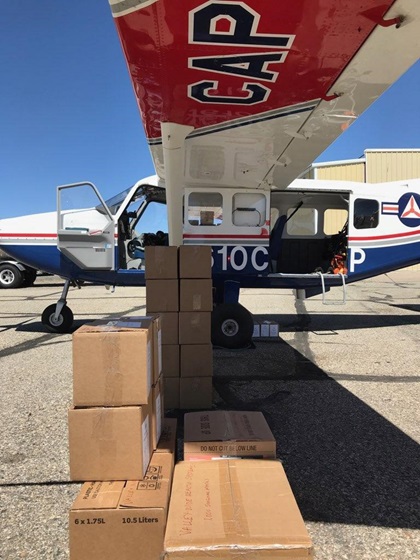'An amazing job you have done'
CAP marks year of COVID-19 relief operations
Small airplanes have done mighty things in the hands of the Civil Air Patrol in the first 12 months of coronavirus pandemic response. The U.S. Air Force auxiliary marked a full year of moving food and critical supplies on March 24, having transported blood, meals, masks, test kits, test samples, and vaccine doses by the thousands.

Day 365 of CAP’s COVID-19 response was typical, with volunteers or seven different CAP wings flying missions on that day, from Arizona (supporting vaccine distribution and collecting blood donations) to New Hampshire (supporting vaccine distribution sites with personal protective equipment supply). It was in some respects just another day, adding to a tally built with a fleet of 560 single-engine Cessnas operated by 54,000 volunteers across the country.
In a year that saw supply chains critically stressed, the auxiliary force that trains in normal times for search and rescue turned its resources into a logistics powerhouse serving far-flung communities.
“What an amazing job you have done over the course of this year,” said Maj. Gen. Mark Smith, CAP’s commander and CEO, in a message to the organization.
 The coronavirus itself was a significant challenge, forcing the organization to limit meetings and, in many places, hunker down with the rest of the population following guidance from the Centers for Disease Control and Prevention. Forty of CAP’s 52 wings are now in the second phase of a three-phase remobilization plan, allowing on-site unit meetings of up to 50 members, and several are being evaluated for readiness to move to the next phase, allowing overnight activities such as encampments, the organization reported. Prospects for continued progress are considered good, provided the pace of vaccinations is maintained, and COVID-19 safeguards continue to be practiced in communities.
The coronavirus itself was a significant challenge, forcing the organization to limit meetings and, in many places, hunker down with the rest of the population following guidance from the Centers for Disease Control and Prevention. Forty of CAP’s 52 wings are now in the second phase of a three-phase remobilization plan, allowing on-site unit meetings of up to 50 members, and several are being evaluated for readiness to move to the next phase, allowing overnight activities such as encampments, the organization reported. Prospects for continued progress are considered good, provided the pace of vaccinations is maintained, and COVID-19 safeguards continue to be practiced in communities.
“Civil Air Patrol remains committed to safeguarding the health of all our members and employees while maintaining mission readiness,” said Brig. Gen. Ed Phelka, the CAP vice commander and leader of a team of subject matter experts who review remobilization plans proposed by wing commanders.
Meanwhile, the work continues to stretch beyond packing big boxes into relatively small airplanes. Missions underway on March 24 included data entry on behalf of state emergency managers in Maine and Maryland; supporting vaccine distribution in North Carolina, Pennsylvania, and Washington; and the Arizona Wing’s collection of 35 units of blood while assisting a vaccine distribution center there.



